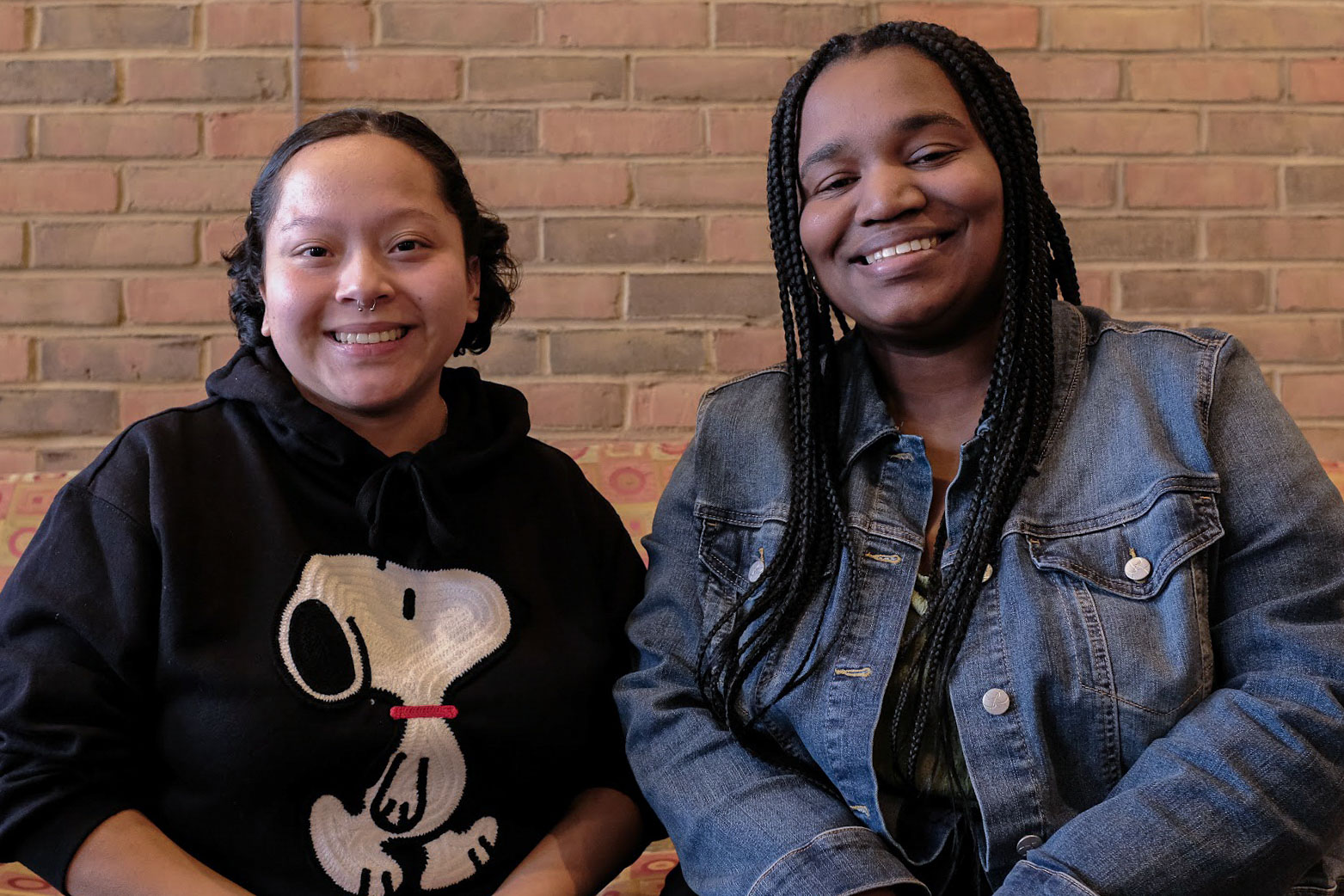Goshen College’s unveiling of a new honors program adds to our list of reservations. The institution has again prioritized its financial agenda over its duty to serve students, leaving us disappointed yet unsurprised.
"Not everyone comes to try out or audition for a sports team or musical."
— Jakyra Green and Mariela Esparza
Many people, especially white people, may perceive some of the ideas we will bring up as separate from the honors program, but we believe they are interconnected and reflective of systemic issues on campus. These issues align with the broader context in which the honors program exists.
Nonetheless, the program is happening. So, we must ask how GC plans to implement it fairly. How does the institution plan to ensure the content is culturally responsive and competent?
According to a Record article published on Nov. 2, 2023, the program’s parameters are open to the incoming class of 2028 and eligible students from any stage, excluding current GC students. It features two GC replacement courses, an upperclassmen capstone, major depth credit, seminars and a research project for the Academic Symposium. Students must also maintain a 3.6 GPA and hold leadership roles.
The ad hoc committee, exclusively made up of white faculty members — Jessica Baldanzi, Kathy Meyer Reimer, Fritz Hartman, Philipp Gollner, and Rob Brenneman (the program director) — was formed through an open call. As for student focus groups, Brenneman explained that the registrar provided a list based on GPA, oversampling for race and ethnicity. Based on our conversations with the committee, the actual student attendance may not have reflected those invited.
There is now a set honors program committee with one representative from each school: Suzanne Ehst, Roy Jackson, Susan Setiawan, and Philipp Gollner.
The Journal National Collegiate Honors Council highlights that Black students are half as likely to be enrolled in college honors programs compared to their campus presence. Hispanic students, while better represented, are 42% less likely.
These statistics are one reason Aja Ellington’s voice could’ve been beneficial as DEI director. She mentioned being unaware of the program, suggesting it might have been discussed before her tenure at this institution. This is concerning, given her crucial role at a Hispanic-serving institution (HSI) and one of the few Black faculty on campus.
After hearing from peers, we created a Google Form which we shared in the Communicator and sent to students and faculty of color to gather their insights. 14 responses reflected the hesitations we harbor about the program.
Specifically, choosing individuals deemed “fit” is, at its core, elitist. Excluding certain people from the focus group raises questions about the criteria used. There was an open call for faculty — why wasn’t there one for all students to have a say in this program?
“Elitist,” according to the Cambridge English Dictionary, is “organized for the good of a few people who have special interests or abilities.”
There is nothing wrong with creating opportunities for inquisitive students who have worked hard to do more. That’s what college is.
The catch is that everyone comes to college to learn — not everyone comes to try out or audition for a sports team or musical. That’s why it is unfair: all students deserve to be academically challenged.
If the problem is that students are not being pushed in their departments to work in interdisciplinary ways, that should be addressed at the institutional level and within departments — not with an honors program.
But here’s why we may feel stuck: GC has a 93% acceptance rate. The academic profile of the average student has changed in the past decades — freshmen are coming in with lower and lower GPAs and SAT scores. This is not bad—all students deserve a chance to pursue higher education.
Simultaneously, it is why faculty feel the need for an honors program; to keep enrollment afloat and the funds coming in, the institution’s academics arguably need to shift.
The Record reports that the humanities have especially struggled to maintain enrollment, declining “8% in their representation in the graduating class for the 10 most recent years.” It’s worth noting that the committee is entirely white and in the humanities.
Admissions at GC is interesting. The institution puts so much effort into bringing students in but does not care for the ones here. They are losing students not because of the state of academics but because of the environment.
If you look at the staff in admissions and the Center for Community Engagement, they are much more racially diverse than other areas of the college. The college is falsely advertising because there are very few faculty of color when students get here.
There are also numerous issues that the institution is aware of that have not been addressed. For example, at an HSI summit last year, students expressed concern about the insufficient financial resources for those marginalized and the shortage of professors and faculty of color, with a concerning turnover trend.
“GC puts out a false image,” said Isis Espinoza, a senior TESOL education major. “I wish they would prioritize strengthening existing programs or addressing institutional problems rather than implementing things we don’t need.”
Abby Nafziger, the head of technical services, is concerned about how “the Honors programs may be used as a recruitment tool when they carry little or no weight in a post-college world.”
We’re also already grappling with divisions — commuters and residential students, athletes and non-athletes, Mennonites and non-Mennonites, white and non-white. These distinctions contribute to an atmosphere of separation. It begs the question: why cause more? It seems counterproductive to fostering an inclusive campus, something GC claims they care about.
It is important to note that we have engaged in repeated conversations with the administration regarding these matters. Students of color have advocated for themselves to the point where GC relies too heavily on us to come to their doors for more conversations that lead nowhere.
There is nothing wrong with hoping students will give feedback. However, it is a problem when not all are asked, particularly in the program’s conception. Additionally, it becomes an issue when we have done so already, and nothing seems to change.
Respondents to the form were also concerned about the unfair advantage students with more resources will have.
First-generation students, a large portion of GC’s population, are one demographic that may have lower GPAs coming into and during college. Sarah Miller, a junior music education major, felt that “some people who may find it easier to enter the program may be able to do so because of the high school that they went to.”
It is not a problem to consider GPA as a factor, but it is not an accurate measure of student success or intelligence: a 4.0 can mean different things across schools; some students might have inflated grades from AP classes and some schools function on a 5.0 scale, while others don’t allow for anything higher than a 4.0.
GPA is not a holistic measure of student success or intelligence, which Brenneman recognizes. However, with only two criteria and no new committee feedback, GPA seems to be a main factor in admittance.
“In high school, many of us didn’t have the same opportunities to excel and have great GPAs,” Espinoza said. “In college, we have more time and access to resources. Having this program based solely on GPA will exclude students.”
A senior nursing major, Ashley Valencia, noted that this program feels targeted towards the “white high achieving student experience who comes into college straight after high school.”
Prospective students were also overlooked. Ann Venderly, the Vice President for Academic Affairs and Academic Dean, shared that her discussions were limited to supportive parents. The Record’s Nov. 2 article highlighted that first-generation students were most interested in the program. Parental perspectives, however, may not fully capture the desires and concerns of the students.
Valencia pointed out that many first-generation parents won’t be fully aware of the workload and responsibilities associated with the program.
While it might sound appealing to these parents, they may not grasp the potential impact on their children, especially in cases where the student is working or from a low-income household.
“The biggest thing is making sure all students have access to support that allows them to be a part of the program,” Valencia said. “The program has the potential to be great once they have focused on making sure students from disadvantaged backgrounds have the opportunity to be a part of it.”
Nafziger shared a similar sentiment, “If [GC] truly seeks to be a place for all high-performing students, it will need to make sure it represents all students, including commuter/residential, white/black/Latinx/etc and on and on.” Concrete plans, not mere conversations that only include a select few, are urgently needed to address disparities at every level of the program.
For four years, we have dedicated ourselves to this institution. In this time, what has changed? We have seen and experienced things we didn’t ask for, like wonderful people leaving, micro and macro aggressions and now, the honors program.
If change didn’t happen while we were here, it must happen for future students, especially the ones who look like us. It must.




